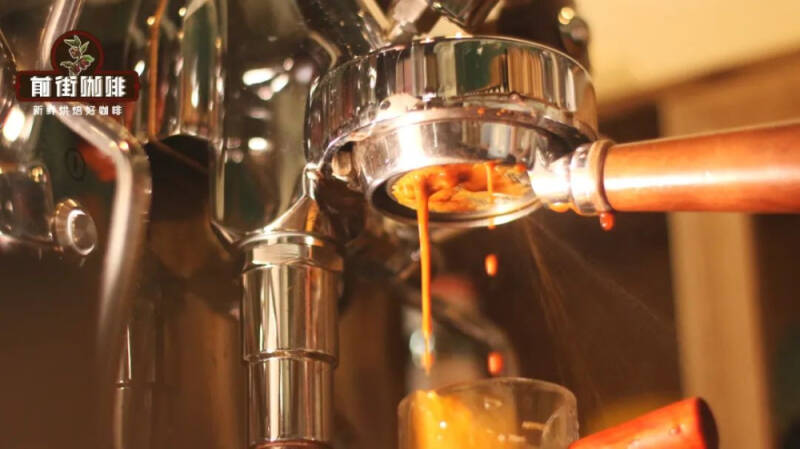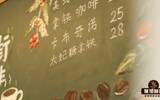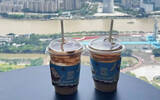Why does it spurt out when making espresso? How to make a standard espresso at home?

I still remember that the first toy coffee machine in Qianjie used a bottomless handle. After imitating the teacher's operation, I pressed the extraction button and saw the first drop of concentration slowly fall into the cup. I happily thought it was steady. Unexpectedly, the vertical liquid column suddenly ejected a small stream of light color, and the flow rate of coffee became fast and slow. At this time, I only heard the teacher standing by and said, "you sprayed again, right?"

(the picture is an exaggeration.)
Why is the concentrate suddenly ejected?
First of all, we need to know that a cup of standard Italian concentrated extraction is inseparable from three elements: fine grinding, high pressure, and short time, that is, the use of high pressure to allow hot water to penetrate the fine ground and compacted pressed powder in dozens of seconds.
Just as people form an escape mentality when they encounter difficulties, under high pressure, the current will give priority to looking for the path with the least resistance. Once the density of the pressed powder is unevenly distributed somewhere, the pressurized hot water will go straight to the most vulnerable position and then quickly eject from the bottom corner of the bowl.
(escaped coffee liquid ~)
If the bottomless handle is used at this time, you will find that this part of the coffee will quickly fade and turn white, and the more the later, the more intense the liquid will release, and even spatter everywhere, which is the "channel effect" that baristas often call it.
In addition to spatter, the channel effect is accompanied by uneven extraction of coffee. When the handle is removed, we sometimes see stagnant water in the powder bowl, or small holes in the coffee grounds. When tasting concentrated, the mouth usually shows a weak aroma, thin body, miscellaneous smell, and with acidity, water, bitterness, astringency and other uncomfortable taste.
In fact, the channel effect can be said to be pervasive, even if experienced baristas are adept at all kinds of cooking equipment and techniques, they will still encounter "channel problems" in the production of concentration, but the intensity of "spray" may not be so exaggerated, and can be quickly adjusted with bar experience. But for family baristas who don't have much experience, they need to find out what the problem is before they can prescribe the right medicine.
What conditions will lead to the channel effect?
1. When making cloth powder, the details are not well done, whether it is video teaching or popular science articles, we are always told of the importance of cloth powder for concentrated extraction. The purpose of the cloth powder is very simple, which is to distribute the coffee smoothly and evenly in the powder bowl, so that hot water can fairly permeate each particle, thus keeping their extraction state as consistent as possible. But often the simpler the details, the easier it is to be ignored.
For example, some partners are always too impatient in the operation, so they pick up the powder hammer to fill it before the powder layer is swept flat, then a gap or inconspicuous pit will be formed on the edge of pressed powder. Card cooking head extraction, seemingly inconspicuous depression will allow hot water to take advantage of, resulting in perforated spray phenomenon.
two。 After cloth powder, the bump of the handle should know that it is not only pressed powder perforation that counts as a channel, but also a gap between pressed powder and the powder bowl. Bumping after cloth powder is often the main culprit that leads to "piercing".
According to the observation of Qianjie, this kind of friends usually move a lot, and when they buckle the handle, they get stuck when they don't find a good angle, so they bump into the cooking head. At this time, the original compact cake body is likely to have been broken, then the possibility of "piercing" will be greatly increased. If you have no problem with the way you spread the powder, but spray often occurs when you concentrate, you might as well pay attention to whether you have this bad habit and avoid it in time.
3. Insufficient powder or too fine grinding theoretically, under the premise of uniform distribution of powder, the greater the resistance of water, the slower the flow rate, then the flavor of extraction will usually be more abundant. However, when the coffee powder is ground too fine, the density of the filled powder layer will become very high, causing great resistance to water, and when it comes to the formal extraction stage, the hot water under high pressure urgently needs an outlet, so find a weak place in the pressed powder, or sneak out along the edge of the powder bowl.
In addition, too little powder will also lead to the problem of coffee liquid spatter. When the amount of powder is too small, pressed powder and the water distribution network to form a certain distance, extraction, the surface coffee powder will tumble violently, then the channel effect will occur at any time. After pulling out the handle, we will find that the surface of the coffee powder is muddy, accompanied by perforation.
If we are not sure whether the grinding scale is found correctly, we can also refer to the time of the espresso extraction formula: 1:2 powder-to-liquid ratio, time 25-30 seconds, powder volume depends on the capacity of the powder bowl. For example, if the reasonable capacity of the powder bowl used in Qianjie is 20g, then extract 40g coffee liquid with 20g coffee powder for 25-30 seconds. If the coffee liquid is slow to drip out (more than 7 seconds), the final extraction time is more than 35 seconds, and the concentrated stage obviously whitens, it means that the flow rate caused by grinding is too slow, so the coffee powder should be thickened.
4. Coffee powder caking in the process of grinding espresso powder, severe friction will produce static electricity (the grinding quality of the bean grinder will also affect), the consequence is that the lighter coffee powder will clump together to form lumps. This kind of caking occurs most often, especially on rainy days with high humidity, coupled with the grinding of grease-rich deep-roasted coffee beans.
Although we will not see any clues after compaction, but this powder usually has a more compact structure, the water here had to find another way to choose a place with less resistance to flow away, and then "perforated". The solution is simple: use a needle dispenser or similar tools (such as toothpicks) to stir the coffee powder in the powder bowl to break up the lump of powder and make the density distribution of the powder layer more uniform.
Can the shunt handle solve the "channel" problem? Seeing this, some friends may think that if you use a bottomless handle to concentrate so that it is easy to splash, can it be solved by changing a shunt handle with a bottom?
Obviously not, although the mechanism with the shunt handle does allow the coffee liquid to be released along the two fixed channels as expected, if the pressed powder is uneven (or above), the hot water will still pick a bigger gap to drill through. On the surface, the flow rate of concentration does not seem to be much of a problem, and it does not splash everywhere like a bottomless handle, but in fact, part of it is over-extracted and part of it is underextracted. when the handle is removed, you can also see conclusive evidence of "perforation".
Therefore, the practice of "switching to a shunt handle in order to avoid channel effect" is actually more like covering your ears and stealing the bell.
-END-
Front Street Cafe
No. 10 Baoqian street, Yandun road, Dongshankou, Yuexiu district, Guangzhou, Guangdong province
Important Notice :
前街咖啡 FrontStreet Coffee has moved to new addredd:
FrontStreet Coffee Address: 315,Donghua East Road,GuangZhou
Tel:020 38364473
- Prev

How to make a flavored latte? What syrup do you add to your Italian milk coffee? Can I add a piece of sugar to stir up the milk foam?
Not all friends can accept the bitterness of coffee, so many coffee shops will set up some flavored lattes on the menu, so that friends who cannot drink the bitterness can also enjoy delicious lattes. (For example, the considerate front street!) The so-called flavored latte is to add various flavored syrups to regular lattes, such as
- Next

High-altitude coffee has become popular, and office buildings have become small waist shooting spots?! Workers break the defense!
▲ Click to pay attention| Daily Boutique Coffee Culture Magazine Coffee Workshop Recently,"High-altitude Coffee" photographed with Guangzhou Xiaomanyao has become popular on social platforms. It can be seen from the photos shared by netizens that they either stood or sat in front of the floor-to-ceiling glass, including the Guangzhou Tower in the distance, themselves and the coffee in their hands into the framing frame
Related
- Customers have "changed" Manner's new products! Shop assistant: Please don't mess around!
- Remove sockets in customer areas at Starbucks stores?! Netizen: I won't go if I really tear it down
- What is the difference between the taste steps of sun-dried coffee and washed coffee? Why is sun-cured coffee sweeter and washed coffee sour?
- The recipe for salty grapefruit dirty is revealed! Coffee Festival salty grapefruit dirty coffee making materials parameters ratio milk share!
- How about the flavor of Sunlight 74158 at Sidamo Banshaha Mathieu Processing Factory in Ethiopia? 74158 Share the proportion of coffee brewing parameters!
- What effect does Italian American coffee with filter paper have? Will coffee taste better if it is put on filter paper at the bottom of the powder bowl?
- What is the color difference in coffee beans? What are the characteristics of honey processed coffee beans? Why are the anaerobically treated coffee beans uneven in color?
- How does novice Xiaobai quickly get started and make coffee? Newbies learn to make coffee by hand and share the specific steps and process process!
- Costa tea has a shelf life of 100 years?! Expert: Unable to verify
- It's a huge uproar! American milk addition was rejected by Manner employees?!

